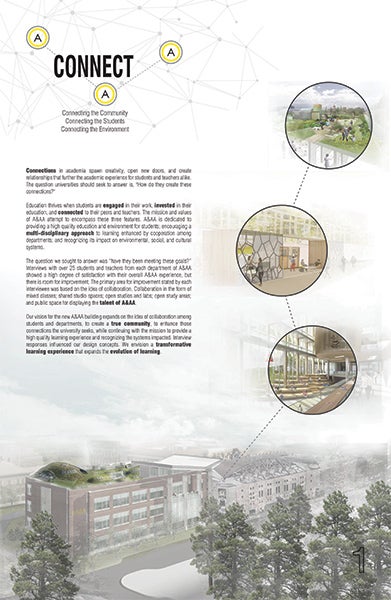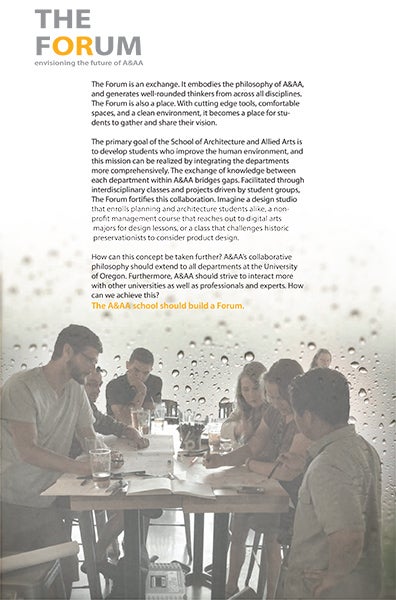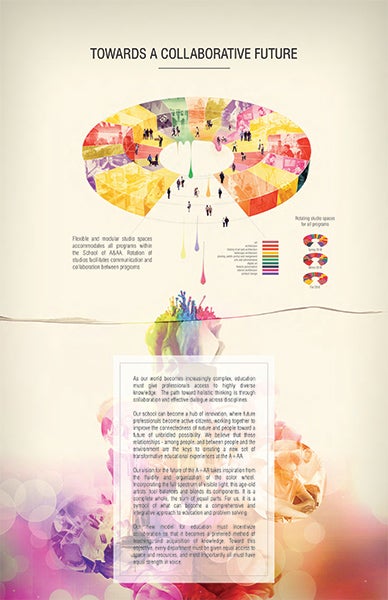A&AA is wrapping up its 100th anniversary this month after a full year of events, exhibitions, and celebrations. The school is now embarking on a capital campaign to imagine the future of art and design education and facilities for the next 100 years. In envisioning the school’s future, the A&AA Building Project Work Group in January issued a request for proposals (RFP) from student teams for a competition to design a transformative learning environment for A&AA. In May, the finalists were announced.
“We believe our highly capable, intelligent and motivated students can teach us a great deal about creative learning today (and tomorrow), and, to that end, we are seeking your help,” the RFP stated. “You are encouraged to … go out on a limb, engage in a thought experiment and creatively imagine the future of education in A&AA.“
The teams were tasked with developing “a transformative learning experience that a future student, student team or class would be involved in. …What are the physical/spatial implications? [How] is the transformative experience best served…? How would students and faculty interact? … How does the illustrated story describe A&AA teaching and learning at its best?”
“Connect” was the title of the proposal by the winning team, comprised of architecture undergraduates Amin Yazdi and Dianna Montzka, and PPPM graduate student Ryan Covey.
“Education thrives when students are engaged in their work, invested in their education, and connected to their peers and teachers,” the students’ design narrative begins. “The mission and values of A&AA attempt to encompass these three features.”
The students interviewed more than two dozen students and teachers from each department of A&AA, through which they learned that “the primary area for improvement stated by each interviewee was based on the idea of collaboration. Collaboration was described as taking the form of mixed classes; shared studio spaces; open studios and labs; open study areas; and public space for displaying the talent of A&AA. … Our vision for the new A&AA building expands on the idea of collaboration among students and departments, to create a true community, to enhance those connections.”
The students proposed to connect the A&AA community through tangibles such as writable walls and windows, a student gallery, and an atrium. Intangibles included open sharing of ideas and increased collaboration via the writable walls, an “advertisement” of A&AA via the student gallery, and increased well-being and visual accessibility to greenery via the atrium.
Connecting students to one another was a critical component of the winning design. The team “focused on the concepts of integration and transparency, concepts we feel are imperative to the new A&AA space.” Their design would achieve these goals via features including integrated studio spaces with glass walls, shared media labs so students from all disciplines could work side-by-side, and wide corridors with conference pods.
A rooftop green space would connect people to the environment “to inspire collaboration, relaxation, and creative thinking. It would also provide the university and A&AA a unique opportunity to showcase their commitment to sustainability, by expanding vertically and utilizing the roof as an academic tool and social space.” The green roof would include solar panels, a rainwater harvesting system, and a wellness lounge, “the most desired [aspect] in the interview process,” the narrative says of the wellness lounge. The lounge would include spaces for recreation, a kitchenette, individual sleeping pods, and an outdoor balcony.
The winners were selected based on originality and power of the story about a transformative A&AA learning experience, quality of narrative and images, overall compositional quality of submissions, and level of inclusiveness for multiple A&AA majors.
Members of the winning team will participate on the A&AA Building Project Work Group through the 2015-16 academic year.
The runners up were:
• “The Forum,” comprised of architecture graduate student Adam Sitterly, architecture undergraduate Thomas Adamson, and PPPM minor/geography undergraduate Riley Champine.
• “Towards a Collaborative Future,” comprised of historic preservation graduate student Terra Wheeler, architecture graduate student Bryan Hadley, and architecture undergraduate Vincent Mai.



